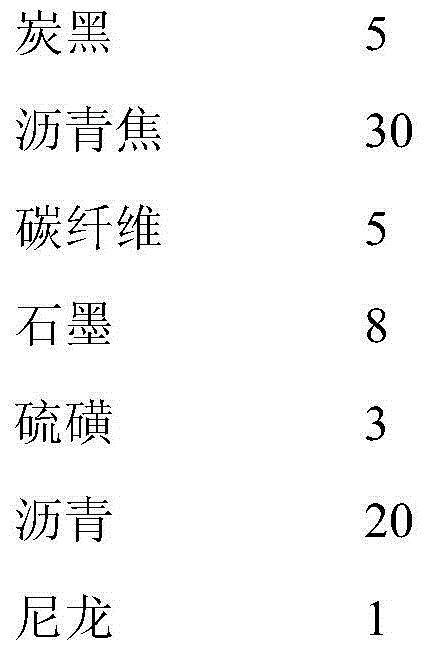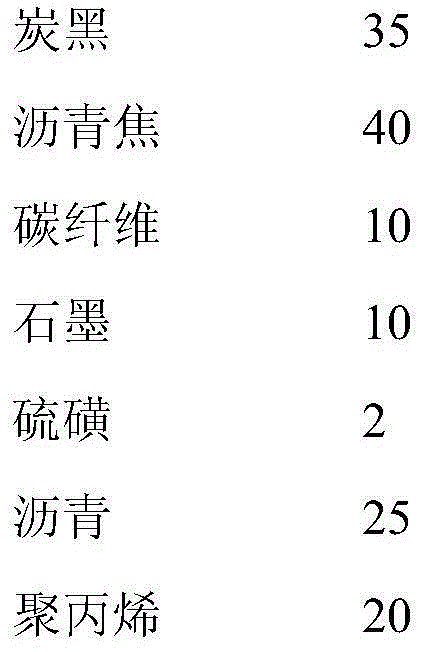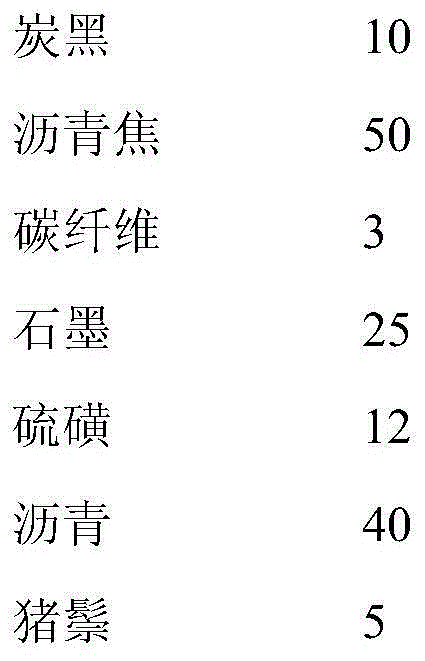Method for making carbon-fiber-reinforced pantograph carbon slide plate carbon strip
A technology for pantograph carbon slides and carbon slides, applied in ceramic products, applications, household appliances, etc., can solve the problems of unreachable and reduced carbon strip resistivity, etc., and achieve long service life, low cost, and low friction coefficient Effect
- Summary
- Abstract
- Description
- Claims
- Application Information
AI Technical Summary
Problems solved by technology
Method used
Image
Examples
Embodiment 1
[0074] 1. Prepare raw materials according to the following weight ratio
[0075]
[0076] 2. Raw material mixing
[0077] (1) Add carbon black, pitch coke, carbon fiber, graphite, and sulfur into the mixer and stir for 30 minutes, and mix evenly to obtain the first mixture;
[0078] (2) Heating the first mixture to 130°C, then adding molten asphalt into the first mixture, stirring for 200 minutes, and mixing evenly to obtain the second mixture;
[0079] (3) The second mixture is placed in the roll machine for the first roll treatment to obtain a sheet material; the sheet material is placed in a pulverizer for crushing to obtain a crushed material; the crushed material is placed in a roll machine Carrying out the second roll treatment to obtain a sheet-like third mixture with a thickness of 1-3mm; wherein the treatment temperature of the roll machine is 100°C;
[0080] (4) placing the third mixture in a pulverizer for pulverization to obtain a fourth mixture with a particl...
Embodiment 2
[0097] 1. Prepare raw materials according to the following weight ratio
[0098]
[0099] 2. Raw material mixing
[0100] (1) Add carbon black, pitch coke, carbon fiber, graphite, and sulfur into the blender and stir for 200 minutes, and mix evenly to obtain the first mixture;
[0101] (2) Heating the first mixture to 210°C, then adding molten asphalt to the first mixture, stirring for 30 minutes, and mixing evenly to obtain the second mixture;
[0102] (3) The second mixture is placed in the roll machine for the first roll treatment to obtain a sheet material; the sheet material is placed in a pulverizer for crushing to obtain a crushed material; the crushed material is placed in a roll machine Carrying out the second roll treatment to obtain a third flake mixture with a thickness of 1-3mm; wherein the treatment temperature of the roll machine is 180°C;
[0103] (4) placing the third mixture in a pulverizer for pulverization to obtain a fourth mixture with a particle siz...
Embodiment 3
[0120] 1. Prepare raw materials according to the following weight ratio
[0121]
[0122] 2. Raw material mixing
[0123] (1) Add carbon black, pitch coke, carbon fiber, graphite, and sulfur into the mixer and stir for 60 minutes, and mix evenly to obtain the first mixture;
[0124] (2) Heating the first mixture to 145°C, then adding molten asphalt to the first mixture, stirring for 90 minutes, and mixing evenly to obtain the second mixture;
[0125](3) The second mixture is placed in the roll machine for the first roll treatment to obtain a sheet material; the sheet material is placed in a pulverizer for crushing to obtain a crushed material; the crushed material is placed in a roll machine Carrying out the second roll treatment to obtain the third flake mixture with a thickness of 1-3mm; wherein the treatment temperature of the roll machine is 110°C;
[0126] (4) placing the third mixture in a pulverizer for pulverization to obtain a fourth mixture with a particle size ...
PUM
| Property | Measurement | Unit |
|---|---|---|
| diameter | aaaaa | aaaaa |
| length | aaaaa | aaaaa |
| particle size | aaaaa | aaaaa |
Abstract
Description
Claims
Application Information
 Login to View More
Login to View More - R&D
- Intellectual Property
- Life Sciences
- Materials
- Tech Scout
- Unparalleled Data Quality
- Higher Quality Content
- 60% Fewer Hallucinations
Browse by: Latest US Patents, China's latest patents, Technical Efficacy Thesaurus, Application Domain, Technology Topic, Popular Technical Reports.
© 2025 PatSnap. All rights reserved.Legal|Privacy policy|Modern Slavery Act Transparency Statement|Sitemap|About US| Contact US: help@patsnap.com



